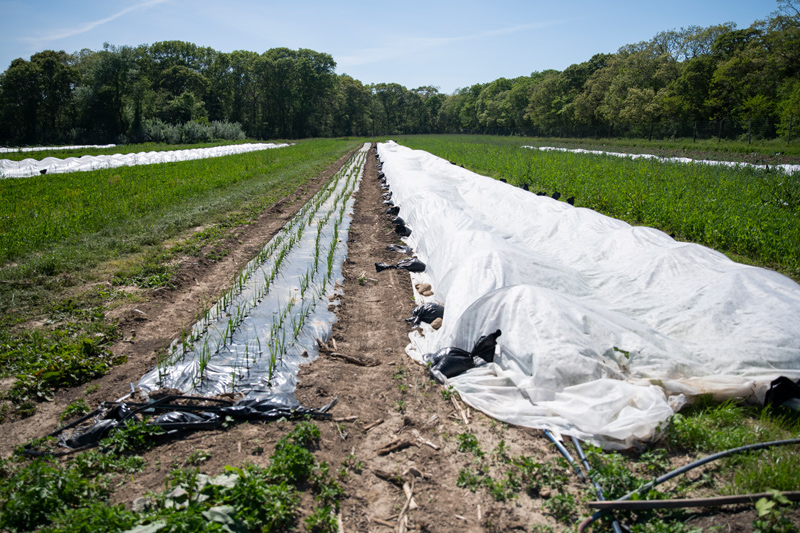When you think of Island Grown Initiative, your mind may wander. It may jump over to Thimble Farm where careful hands are tending to acres of produce. Maybe you think about community lunches on a hot summer day, where Islanders of all ages gather for a free (yes, free) meal reaped from the bounty over at the farm. Maybe you’re brought to the Mobile Market, that dark green truck packed with, again, all that locally grown goodness (and goodness from partnering farms). Maybe you think about that workshop you attended, or the gardening class your kids rave about, or that counter compost container you’ve been meaning to empty.
By now, you’ve probably noticed a few themes: food, farming, sharing, community, education, the environment. IGI is an advocate for all of it. And to best meet the demands of this Island community, it is constantly shifting, adapting, and reimagining.
“The right food, at the right time, in the right form, to the right people,” says executive director Rebecca Haag.
So in early March, as signs of an impending pandemic loomed, Martha’s Vineyard’s largest food and farming nonprofit met the moment.
Two days before Governor Baker shut down Massachusetts to slow the spread of COVID-19, IGI laid out a plan to make sure there was coordination between the Food Equity Network (a group of Island organizations committed to food distribution and food equity) and Martha’s Vineyard Community Services (the Island’s largest nonprofit, period). With all of these groups on the same page, IGI got to work.
“Frankly, I don’t think I’ve been busier,” Haag said. “We’re having to rethink pretty much everything we’re doing.”



Increasing food production
If you’re anything like everyone right now, you’re probably avoiding the grocery store at all costs. You’re noticing empty shelves. You’re more tuned into where this product came from and how it got here. How many hands have touched it? How many opportunities for cross-contamination? Maybe you’re noticing the fragility of a commodity-based food system. And as a result, you’re eyeing local food, perhaps like never before. So IGI is producing more.
Thimble Farm is a 13-acre farm with eight acres dedicated to regenerative farming practices (integration of cover crops, low-to-no tillage, animal rotation, and an emphasis on soil biodiversity). This summer, IGI is increasing that regenerative field by two acres.
“All the food we’re growing on those two acres we will either give away or sell at the Mobile Market,” Haag said.
IGI has also reconfigured its 30,000 square foot hydroponic greenhouse — a formerly soil-less system where food was grown in water tables and fed nutrients. “With our transition as an organization to regenerative practices, we knew we wanted to move to more soil-based systems, and the COVID crisis gave us this chance,” said Noli Taylor, IGI’s senior program director. As schools closed and IGI educators were redeployed to the farm, (and thanks to a donor), they were able to plant 14 new soil beds in the greenhouse, which will yield mixed greens, radishes, tomatoes, and arugula, among other crops.


IGI has also doubled their number of laying hens so they can double their egg production, and thanks to another donation, they now have a walk-in freezer to store an influx of donated meat. IGI also extended their winter soup and stew processing, which usually ends in March, by five weeks, producing another 500 quarts of soup.
“We’re anticipating 35,000 to 40,000 additional pounds of food that we’ll be able to do this year,” Haag said.
“Local food is how we keep people fed through challenging times,” Taylor added.
Raising funds and awareness around food equity
If you planned on resuming your three-to-five job hustle this summer, that’s likely not going to happen.
“Next winter is going to be really hard here,” Haag said. “My concern is families that were already living paycheck-to-paycheck. Servers who rely on big paychecks. Who are these people and how do we support them?”
IGI is raising money for food equity, and diverting funds by major donors to other groups that combat food insecurity like the Island Food Pantry, the Good Shepherd Parish, and Serving Hands.
And with the help of M.V. Community Services, an online resource now exists to ensure there are enough volunteers within each food equity group. “Everyone is working collaboratively and cooperatively to make sure we can fill this big demand,” Haag said.
But on the other side of things, Haag emphasizes there’s always been food insecurity on the Island.
“We’re driving home the reality of the fact that if you are a member of our community, and something happens to you, there is help,” Haag said.


Rethinking IGI’s programming
IGI has had to rethink a lot. Its free community lunch program, which launched in 2017 to ensure Island students had access to healthy lunches over the summer, was a top concern.
“It’s a really wonderful community event where people of all ages and across all the economic spectrums share a delicious meal together in community spaces,” said Taylor. “Everything about that program has to change, because so much about it is about bringing people together around the table.”
Traditionally held at libraries, and at the Boys and Girls Club, IGI is working with Island schools as potential pickup sites, and discussing the logistics of home delivery. Taylor also anticipates the need for prepackaged lunches, and thus even more volunteers.
The Mobile Market may also take on a different form this summer, and may shift toward an online, no-touch system, with IGI staff handling all the bagging. “We haven’t quite nailed down that structure yet,” Taylor said.
Also new this summer is a community supported agriculture program — an extension of IGI’s winter CSA that began in 2018. Taylor said the summer program is “pretty small” at 60 shares, and IGI plans to have 100 shares for the winter, but it’s another way to meet the demand for local food.
IGI educators, in addition to providing extra hands on the farm, have also started an “Island Grown at Home” newsletter to continue their classroom lesson plans, offering tips, information about gardening materials, plant identification, and bug identification — now not only accessible to students, but to the larger Island community.
“We’ve seen such a huge increase in interest in home gardening,” Taylor said.

There is also a continued focus on collecting food waste to then be composted and used as fertilizer (another regenerative farming practice). This year, with many restaurants operating at limited capacities, IGI is reorienting that program toward residential food waste, and exploring the possibility of what home food waste pickup could look like. They’ve also launched a 6-week food waste challenge to encourage Islanders to not only collect, but monitor their behavior, and reduce their food waste.
Island Grown Initiative has always had three main priorities: the farm, community food education, and food equity and recovery.
“In some ways, this crisis has just extended those needs,” Haag said. “This farm, this nonprofit, is a place that should always be serving the community. A place to scale up production. A place to keep employees employed.
“We knew right away — even if the immediate health crisis was going to be short, the economic crisis will be felt for a long time, and we’ll be here.”
For more information on Island Grown Initiative, visit igimv.org. For more information on IGI’s school programming and the “Island Grown at Home” newsletter, visit islandgrownschools.org. For comprehensive information about food resources, how to donate, and where to volunteer, visit mvcommunityservices.org/foodresources/.
Brittany Bowker is a former Times editor and reporter. She now works for the Boston Globe from her home in Edgartown.

